Though they’re one of the two oldest NHL franchises to not win a Stanley Cup championship, the Buffalo Sabres have cultivated a rich history over their 53 years of existence. They’ve produced some of the most memorable moments in the history of the game, and some of the all-time greats have worn their jersey, but who truly stood out the most?
Fans have a consensus over who the greatest Sabres are, but when taking a closer look over the years, who truly made the biggest impact? Let’s go over the five decades of hockey in Buffalo and determine the team’s best player of each specific decade was. We’ll judge based on statistics, but also other factors and intangibles. Some may be obvious, while some might be a surprise. Since we’re only three years in, we’ll omit the 2020s.
The 1970s — Gilbert Perreault
Every team needs a foundation, and the Sabres laid about as good of one as they could. They selected Gilbert Perreault with the first overall selection of the 1970 NHL Draft (their first ever), and the rest, as they say, is history. The highly-touted center instantly became the cornerstone of the new team and won the Calder Trophy as rookie of the year in their first-ever season, with his effortless skating and superb handling making him a sensation. It was the following year, though, that Perreault and the Sabres found their identity.
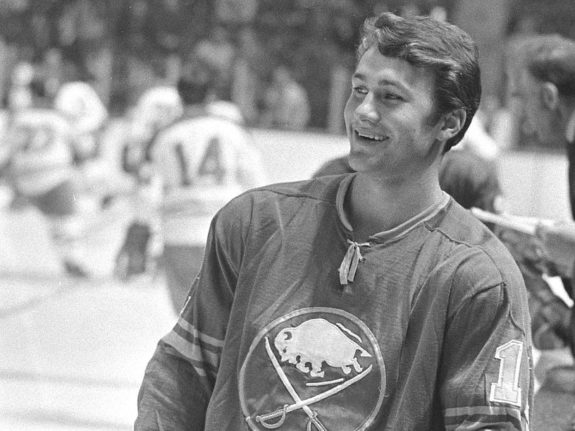
Fellow Quebecois Rick Martin and Rene Robert were added to the mix in 1971-72 and joined Perreault to form the fabled French Connection, propelling Buffalo into the limelight. The team made it to the Stanley Cup Final in just its fourth season, and the line was the biggest reason. They helped the Sabres become one of the better teams of the 1970s and continued to dominate until Robert was traded in 1979. The numbers of all three hang together from the rafters of KeyBank Center.
While Martin and Robert were excellent in their own right, Perreault was always the most essential piece because of his ability to create plays and convert chances, and he eventually became team captain. Inducted into the Hockey Hall of Fame in 1990, he played his entire career with the Sabres and was the only player to ever wear No. 11 for them. He remains their all-time leader in games played, goals, assists and points 37 years after he called it quits and will always be the definitive Buffalo Sabre.
Honorable Mentions: Rick Martin, Rene Robert, Danny Gare.
The 1980s — Phil Housley
Perreault remained a force until his retirement in 1986, but as the team entered its second decade of existence, the next generation took the reigns. The Sabres had always possessed a strong offense and solid goaltending to that point, but the one thing they had lacked was a superstar defenseman. Enter Phil Housley, drafted sixth overall in 1982. Selected directly out of high school, the American bypassed the minor leagues and joined the Sabres immediately for the following season. Though, at the time, it may have seemed like Buffalo was making a gamble, Housley immediately proved it wasn’t.
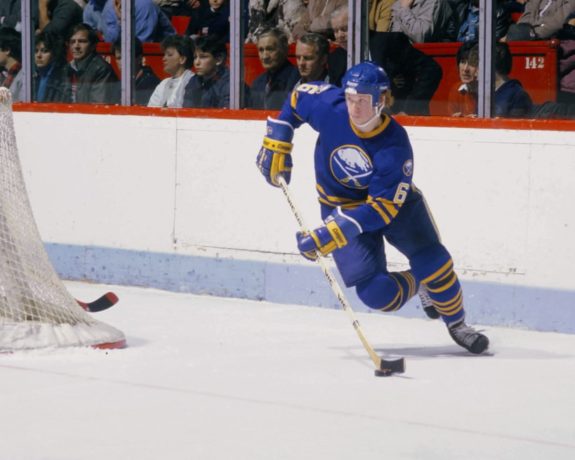
He immediately made the Sabres more dynamic and, alongside Dave Andreychuk (drafted 10 spots after him), carried the team throughout the decade. His 66-point rookie season in 1982-83 remains an NHL record for an 18-year-old blueliner, and he followed that up with a 30-goal sophomore effort, the only Sabre defenseman to ever do so. The team missed the playoffs only twice in his eight seasons, and he never recorded less than 60 points in that span, consistently placing among their scoring leaders.
Related: Sabres Should Sign Buffalo Native Patrick Kane
Housley retired in 2003 as the longest-playing and highest-scoring American in NHL history, thanks in large part to his years in Buffalo. Though he was traded to Winnipeg in 1990, the mark he left on the Sabres is undeniable, and he remains one of their all-time greats. He was inducted into their team’s Hall of Fame in 2007 and the Hockey Hall of Fame in 2015.
Honorable Mentions: Dave Andreychuk, Tom Barrasso, Pierre Turgeon.
The 1990s — Dominik Hasek
There’s no surprise whatsoever on this one. The Sabres had their eye on Dominik Hasek for a while prior to acquiring him in the summer of 1992, but it’s probably fair to assume they weren’t expecting what came next. The netminder took both the Sabres and the NHL by storm and emerged as a superstar the caliber of which the game had never seen before. His “flopping” style of play proved to be highly effective despite its unconventionality, and it made him must-see TV.
It can be argued that no player was ever more valuable to the Sabres during their tenure than Hasek. Their ownership struggled financially in the latter half of the decade and couldn’t afford many other big names. As a result, he became the most integral part of the team, and their chances essentially hinged on him. He had no problem handling that pressure, however. That decade, the Czech won five Vezina Trophies as the NHL’s top goaltender in addition to two Hart Memorial Trophies as NHL MVP (the only goaltender to do so twice). He added an Olympic gold medal in 1998.
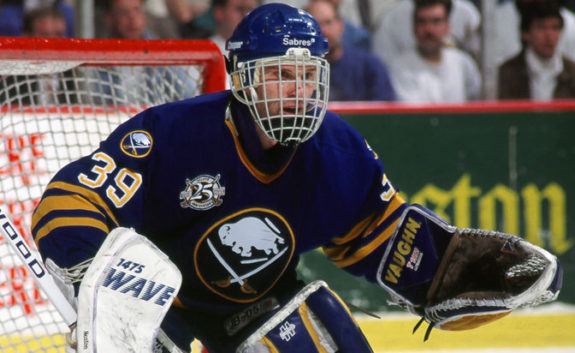
Hasek wasn’t just the best player on the Sabres in the 1990s, but arguably in all of hockey. Contemporaries Patrick Roy and Martin Brodeur both won the Stanley Cup that decade while Hasek didn’t, but neither of them could match his individual accomplishments. In addition to his numerous awards and honors, he’s also the only goaltender in NHL history to have the highest save percentage in the league despite facing the most shots per 60 minutes, a feat he achieved twice in Buffalo.
The Sabres traded him in 2001, and it marked the end of one of the most exciting periods in their history. The team inducted him into its Hall of Fame in 2014 (the same year he was inducted into the Hockey Hall of Fame), and his No. 39 received its long-overdue retirement the following year.
Honorable Mentions: Pat LaFontaine, Alexander Mogilny, Michael Peca.
The 2000s — Ryan Miller
The noughties were a very strange decade for the Sabres and filled with both the highest of highs and lowest of lows. The team had to clean house after a fraud scandal by parent company Adelphia, and a new owner eventually took the reigns. They brought in a host of new players over a grueling two-year stretch, but many proved to be surprisingly excellent fits. And though not much was thought of him at first, a new cornerstone would eventually come forth.
Ryan Miller was an unlikely candidate to make the NHL after the Sabres took him in the fifth round in 1999. However, the combination of Hasek’s departure and the 2004-05 Lockout opened a door, and he took full advantage. Oddly enough, the lockout proved to be very beneficial for Buffalo, as a number of young players received a free extra year of minor league development.
When the Sabres resumed play, Miller established himself as their new No. 1, and they immediately took off, making it to the Eastern Conference Final in consecutive years in 2006 and 2007. Unfortunately, managerial incompetence caused the team to implode on itself afterward, and the next seasons saw a significant regression.
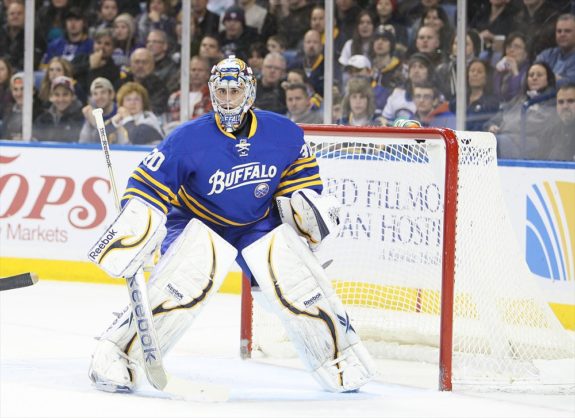
Despite this, the American continued to play excellently, winning the Vezina Trophy, an Olympic silver medal and tournament MVP honors in 2010. The biggest crime of his tenure with the Sabres was that they were never able to capitalize on his tremendous efforts. They made the playoffs just four times in his nine seasons as the starter, and he was eventually traded in 2014. Nevertheless, Miller held down the fort for the Sabres throughout the strangest period of their history, and his No. 30 was rightfully retired earlier this year.
Honorable Mentions: Martin Biron, Chris Drury, Daniel Briere.
The 2010s — Zemgus Girgensons
The 2010s started optimistically for the Sabres but proved to be the most disastrous decade in their history. A new ownership group purchased the team in 2011, and while it brought energy and enthusiasm initially, it would soon fade away. The years that followed were plagued by executive meddling and near-constant turnover, and it spawned the longest postseason drought in NHL history (which is still ongoing). Fans had very little to cheer for, and every time it seemed that hope was building, it would quickly get trounced.
As a result, most players that came aboard over the decade didn’t stand a chance. A major exception is Zemgus Girgensons, drafted 14th overall in 2012. He arrived on the Sabres at perhaps the most inopportune time possible and had to find his way while the team was continuing its perpetual downward spiral. The current longest-tenured Sabre, a vast majority of his time in Buffalo has seen the team consistently failing. In spite of that, he’s stuck it out, and the coming season will be his 10th in the blue and gold.
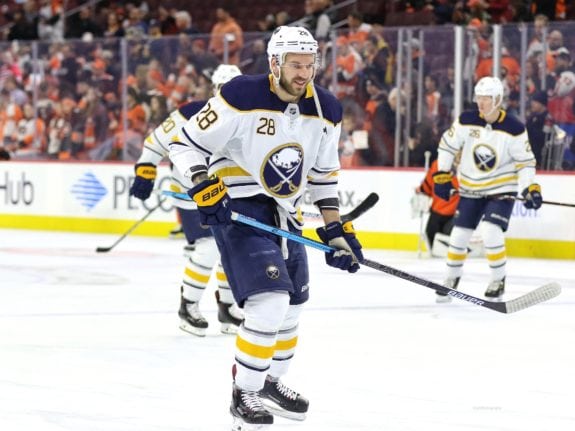
The other players on this list were so valuable to Buffalo largely because of their play on the ice. But in Girgenson’s case, it lies elsewhere. He’s not the best player on the team, and you’ll never see him atop the stat sheet. Instead, it’s his character that sets him apart, and nobody can deny the positive presence he’s been since he arrived. In spite of all that he’s had to endure, he brings leadership, integrity and work ethic to the table, and the young and growing Sabres are all the better for it. They seem to be on the cusp of returning to the postseason at long last, and if they do, it will be an extremely well-deserved reward for The Latvian Locomotive.
Honorable Mentions: Jack Eichel, Ryan O’Reilly, Jason Pominville.
What Will The 2020s Bring for Buffalo?
It looks as if the Sabres have finally found a way out of their doldrums of the last decade, and they look primed to take another big step forward next season. With a plethora of young talent including Rasmus Dahlin, Tage Thompson and Dylan Cozens, brighter days appear to be on the horizon in Western New York after what seemed like an eternity in oblivion. It’s interesting to wonder whom we’ll look back upon as the Sabres’ best player of the 2020s, but we’ve got a while to go before we get to that point.
